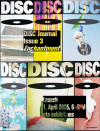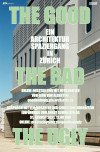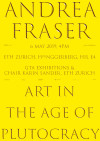
OMARA Mara Oláh
DIKH OMARA
With contributions by Peter Bencze, Timea Junghaus, Ábel Sánta, Selma Selman, Everybody Needs Art, RJSaK ARCHIV, RomaMoMA and a display by Studio Caruso. An exhibition curated by Fredi Fischli and Niels Olsen
2 October – 9 November 2024
gta exhibitions at ETH Zurich, ONA Fokushalle, Oerlikon
Neunbrunnenstrasse 50, CH-8050 Zurich
Opening hours: Tuesday, Friday and Saturday, 10 am – 6 pm
Opening: 1 October 2024, 6pm
18 October 2024, 6pm
Talk by Timea Junghaus
Followed by a guided tour by Mo Diener
Organized in collaboration with RomaMoMA and the Roma Jam Session art Kollektiv ARCHIV, the event is dedicated to the legacy of the artist Omara. Junghaus will speak about the practice of Omara and RomaMoMA, followed by a guided tour on the Roma Jam Session art Kollektiv ARCHIV by Mo Diener. While the former collective worked on morphing the Roma label from a Swiss context, Junghaus is the Executive Director of the European Roma Institute for Arts and Culture that initiated RomaMoMA in collaboration with the OFF-Biennale Budapest.
Presenting more than one hundred paintings, drawings, videos, artists’ books and photography, gta exhibitions, ETH Zurich is pleased to announce the first comprehensive monographic exhibition of OMARA Mara Oláh (1945 – 2020) in Switzerland. Moving into a large post-industrial hall in the neighborhoods of Oerlikon and Seebach, gta exhibitions expands its premises for this special occasion.
Soon after Omara began to paint in her early forties, she took programmatic decisions to create self-supporting environments. One was to apply her daughter’s favorite color in the foundational Blue Series. There, she depicts episodes from her life, reflecting on motherhood, childhood memories and precarious labor conditions. The scenes in these tableaus are tinted a personal, tender blue. Defining her own politics of representation, Omara created a specific artistic method beyond figurative painting. She began inscribing a bold layer of language straight across her compositions. As annotations, this layer of text would challenge ambiguities by stating clear messages, demands and critiques. Informed by other media like television or protest panels, the work escapes the confines of mute pictures. Beyond narrative verbalization, she applied text to wood, canvas and paper, thus creating scores for her own performances and provocative enactments. An outspoken activist, she is of Roma origin herself and was born in Monor, Hungary. She challenged systemic exclusion, injustice and racism. She appeared on television and published in journals. By visiting prisons to talk to the inmates about the life of the Roma, Omara advocated for more inclusive (art) institutions. As an ongoing installation, Omara would collect works by befriended artists and show them in her place in Budapest. She declared that her home was the first museum dedicated to Roma artists. Omara’s work gained both national and international recognition. In 2007, she was featured at the first Roma Pavilion of the Venice Biennale and in 2022 her work was included in Documenta 15.
The exhibition is organized in collaboration with Everybody Needs Art and RomaMoMA. It includes RomaMoMA’s showcase of its nomadic library – “a library on the road” – created as a study room for Roma art and cultural history. By shedding light on a form of institution that speaks to the current crisis challenging “The Museum,” the show returns to a subject addressed in the earlier themed exhibition Unschöne Museen at gta exhibitions, ETH Zurich. Recognized by the International Council of Museums (ICOM), RomaMoMa is not bound to a permanent building; instead, it is a collective contemporary art project, involving various communities. In the words of its co-founder Timea Junghaus, it is “an imagined and yet real space that is home to Roma arts and artists. The suffix in the title, MoMa (Museum of Modern Art) is a reference to prototypical, contemporary museums of art; it also emphasizes the dominant role of museums in processes of canonization, as well as the lack of self-representation by minority groups in museum collections.”
Further materials on Omara, such as the documentary by the filmmaker Ábel Sánta, are complemented by a text-based painting on scrap metal by the contemporary artist, activist and educator Selma Selman. Roma Jam Session art Kollektiv ARCHIV presents work from different collections and in several media, such as costumes, a video, masks, clothing and posters. From a Swiss context, the collective worked on morphing and transforming the Roma label. The studio of Adam Caruso developed a newly commissioned exhibition display consisting of wooden panels propped against the industrial hall’s glass walls, which, along with the dense accrochage of paintings and drawings, recalls large billboards along construction sites.
This exhibition is indebted to the Artist-in-Residence Program made possible by the Thomas and Doris Ammann Foundation.
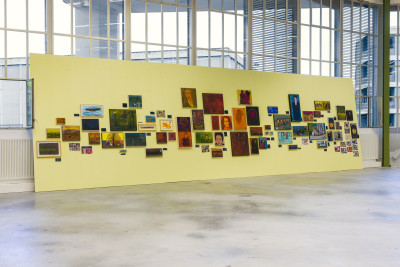
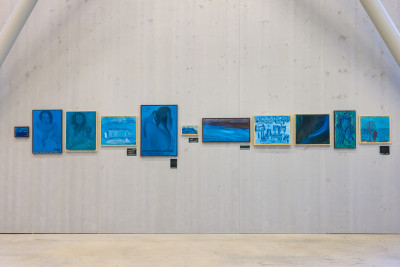


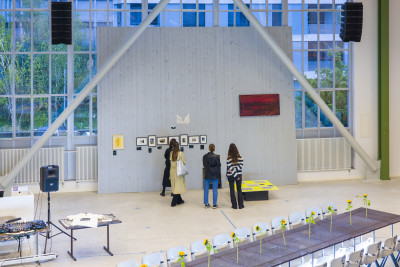

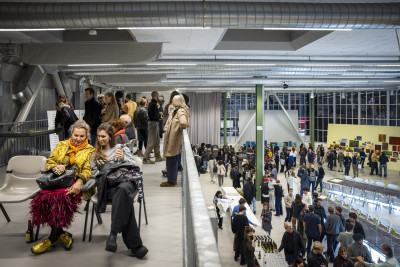

Photographs by Nelly Rodriguez

